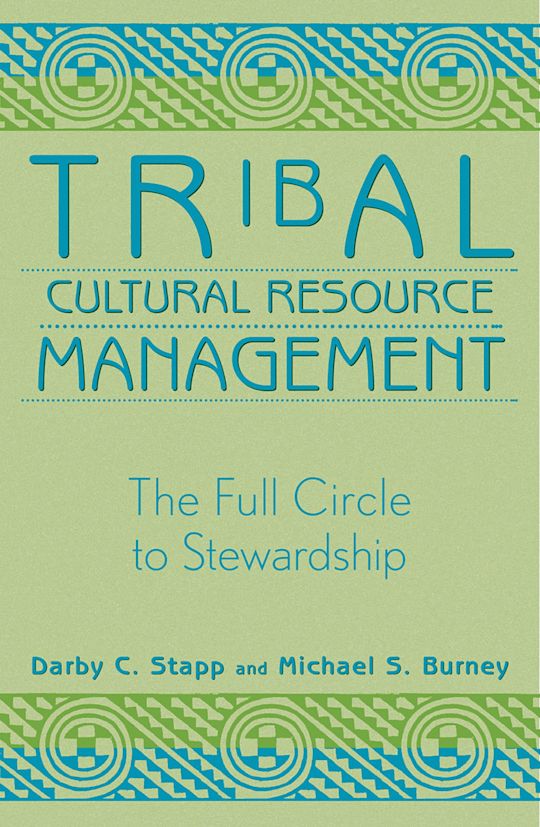- Home
- ACADEMIC
- History
- History - Other
- Tribal Cultural Resource Management
Tribal Cultural Resource Management
The Full Circle to Stewardship
Darby C. Stapp (Author) , Michael S. Burney (Author) , Jeff Van Pelt (Foreword) , Robert Whitlam (Other primary creator)
- Textbook
Tribal Cultural Resource Management
The Full Circle to Stewardship
Darby C. Stapp (Author) , Michael S. Burney (Author) , Jeff Van Pelt (Foreword) , Robert Whitlam (Other primary creator)
- Textbook
Exam copy added to basket
Choose your preferred format. Please note ebook exam copies are fulfilled by VitalSource™.
Buy from Bloomsbury eTextBooks
You are now leaving the Bloomsbury Publishing website. Your eBook purchase will be with our partner https://www.vitalsource.com.
Your credit card statement will show this purchase originating from VitalSource Technologies. They will also provide any technical assistance you might require.
You must sign in to add this item to your wishlist. Please sign in or create an account
Description
The entrance of Native Americans into the world of cultural resource management is forcing a change in the traditional paradigms that have guided archaeologists, anthropologists, and other CRM professionals. This book examines these developments from tribal perspectives, and articulates native views on the identification of cultural resources, how they should be handled and by whom, and what their meaning is in contemporary life.
Sponsored by the Heritage Resources Management Program, University of Nevada, Reno
Table of Contents
Part 2 Preface
Part 3 Part One: Tracing the Roots of Tribal Cultural Resource Management
Chapter 4 Chapter 1: Defining Tribal Cultural Resource Management
Chapter 5 Chapter 2: The Early Years: Archaeology and American Indians - 1492 to 1960
Chapter 6 Chapter 3: Archaeology, Anthropology and American Indians - 1960 to 1980
Chapter 7 Chapter 4: Archaeology, Anthropology and American Indians - the 1980s and 1990s
Chapter 8 Chapter 5: Case Study: The Cultural Resource Protection Program of the Confederated Tribes of the Umatilla Indian Reservation
Part 9 Part Two: Implementing a Tribal Cultural Resource Management Agenda
Chapter 10 Chapter 6: Developing a Tribal Cultural Resource Protection Program
Chapter 11 Chapter 7: Consultation: The Cornerstone of Tribal Cultural Resource Management
Chapter 12 Chapter 8: Cultural Landscapes and the Challenge of Protection
Chapter 13 Chapter 9: Promoting a Cultural Resource Stewardship Agenda to Address Tribal Interests and Expectations
Part 14 Part Three: The Future of Cultural Resource Management
Chapter 15 Chapter 10: The Fruits of Synergy
Part 16 Afterword by Robert Whitlam
Product details
| Published | Oct 23 2002 |
|---|---|
| Format | Ebook (Epub & Mobi) |
| Edition | 1st |
| Extent | 208 |
| ISBN | 9780759116443 |
| Imprint | AltaMira Press |
| Series | Heritage Resource Management Series |
| Publisher | Bloomsbury Publishing |
About the contributors
Reviews
-
Essential reading for archaeologists and others involved in the cultural heritage management of Indigenous sites.
Claire Smith, President, World Archaeological Congress
-
Stapp and Burney's Tribal Cultural Resource Management is a must for anyone who works in historic preservation and CRM! Each year I meet hundreds of students and countless agencies, and this book is the only one that provides a comprehensive background to anthropology and CRM from a tribal perspective. Understanding historic preservation through a tribal perspective has become a prerequisite for those that intend to work in cultural resource management; this book serves as an invaluable resource-a veritable CRM bible!
Rhonda Foster, Cultural Resource Director for Squaxin Island Tribe, Tribal Historic Preservation Officer
-
[The authors] provide excellent coverage of the legal aspects of tribal sovereignty over cultural resources and Tribal Historic Preservation Officers...[this book is] a "must read" for archaeologists, but will also be fascinating to others concerned about cultural property rights and changes in Native American sovereignty.
Larry J. Zimmerman, Indiana University-Purdue University, Indianapolis, Key Reporter
-
This book may be one of the most important books ever published on the subject of tribal cultural resources management. Friends like Darby and Michael have assisted us in coming back full-circle to place (sacred sites), to our original responsibilities to take care of the land and our cultural resources. For me, coming full-circle means coming together with the ones who were here before, to be one with the spirit, and the mind. For Indian people, this work feeds the spiritual part of the body. We understand the knowledge of our past generations, and through those who were here before we know our purpose. Our purpose is to make decisions that will bring us (all of us) better water, air, and a better way of life. This book will surely be a guide for cultural resources managers and the future of archaeology.
Jeff Van Pelt, Cultural Resources Protection Program, Confederated Tribes of the Umatilla Indian Reservation

































